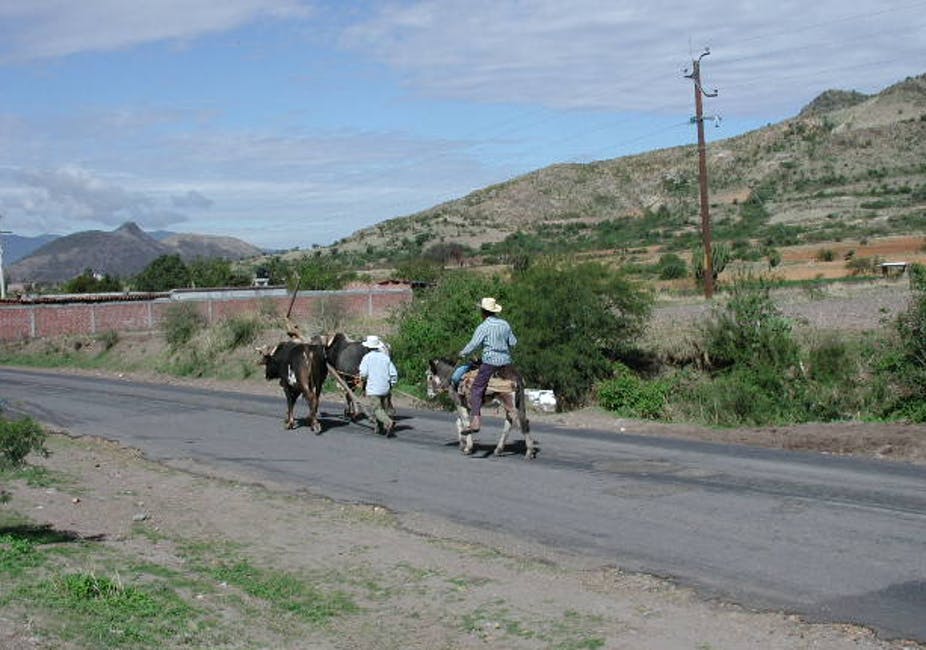By Jeffrey H. Cohen, The Ohio State University
While the coronavirus hammers Mexico, some Indigenous communities in the southern Mexican state of Oaxaca are finding creative ways to cope.
Oaxaca, one of Mexico’s poorest and most ethnically diverse states, is home to numerous Indigenous communities, including the Zapotec people. I have spent many years in the central valleys of Oaxaca conducting anthropological research in rural Zapotec villages, documenting the people’s lives, migration patterns and food culture.
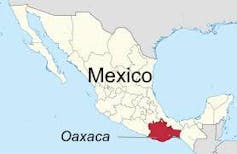
TUBS/Wikimedia Commons, CC BY
Now, my summer research in Oaxaca canceled due to the pandemic, I am learning from afar how the Zapotec are confronting the coronavirus given such complicating factors as chronic poverty, inadequate health care, limited internet, language barriers and a lack of running water.
Working with colleagues at Mexico’s Universidad Tecnológica de los Valles Centrales de Oaxaca and scouring online media resources, I find the Zapotec are surviving the pandemic by doing what they’ve always done when the Mexican government can’t, or won’t, help them: drawing on local Indigenous traditions of cooperation, self-reliance and isolation.
So far, it’s working. While infections and death are rising relentlessly across Mexico, many Indigenous communities in Oaxaca remain largely insulated from the coronavirus. The Indigenous Mixtec village of Santos Reyes Yucuná reported its first infection on July 17, for example – four months after COVID-19 reached Mexico.
Indigenous survival strategies
Cooperation is a cornerstone of Zapotec life in Oaxaca. A history of social exclusion by the federal government reminds the Zapotec not to rely on politicians to save them.
People work together from a young age, joining together in “tequio,” or communal labor brigades, to complete projects that can range from painting a school to repairing the electrical grid. Individuals, their families and their friends routinely work together to make small jobs go quickly and to make big jobs seem less overwhelming.
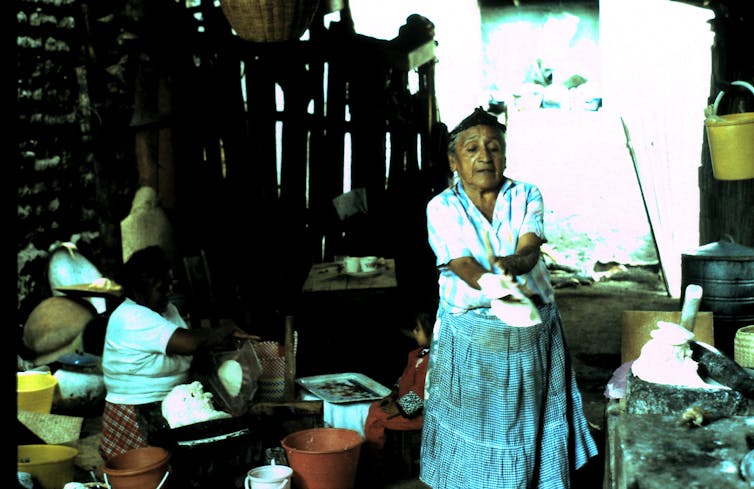
Jeffrey H. Cohen, CC BY
The Zapotec also maintain relative isolation from broader Mexican society, my research shows. They grow food in their “milpas,” or garden plot, to supplement store-bought fare, and police their own communities with volunteers called “topiles.” With high levels of community trust and a history of self-rule that predates the Spanish conquest, the Zapotec who continue to live in rural Oaxaca neither need nor allow much outside access to their villages.
These three aspects of traditional Zapotec culture – cooperation, isolation and self-reliance – are all helpful in a pandemic.
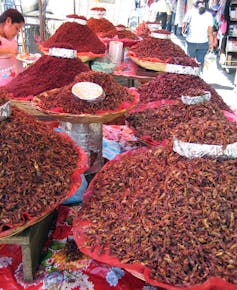
Jeffrey H. Cohen
According to researcher M.C. Nydia Sanchez of Oaxaca’s Universidad Tecnológica, Zapotec families are sharing scarce resources like food, information, water and face masks in what’s called “guelaguetza,” the practice of working together and gift-giving.
And at a time when Mexico’s food supply chain is under stress, villagers are ensuring no one goes hungry by ramping up their crop of “maiz,” the corn used to make tortillas.
“Chapulines” – grasshoppers harvested from the fields and quickly toasted over a fire – are returning to the table as a protein-rich alternative to expensive, store-bought meats that are no longer available locally.
Consensus rules
The tight-knit nature of Zapotec communities can, however, also complicate other measures critical to limiting residents’ exposure to infection.
These are small villages of no more than a few thousand souls. Everyone knows everyone, and it is typical for Zapotec people to spend much of their day together with family and friends. This can make it difficult to maintain the social distancing recommended by national health officials.
[You need to understand the coronavirus pandemic, and we can help. Read The Conversation’s newsletter.]
“To no longer greet each other so much on the street [is difficult], because we are used to it,” a Zapotec man named Jose Abel Bautista Gonzalez told Reuters in April. “It is a tradition, the culture of the people.”
Rather than closing their doors to family and friends, then, the Zapotec are aiming to stop COVID-19 from getting in at all.
Across much of Oaxaca, villagers are building barricades made of chain, stones and wood to physically block access into and out of their communities, which are typically served by only one road. Many villages are effectively quarantined from society.
“We decided to set up these barriers so that visitors or outsiders wouldn’t be coming in,” José Manzano, of San Isidro del Palmar, told Global Press Journal on June 28.
Such decisions, like most Zapotec policies, are built upon community consensus – not made on the order of a local or national political leader.
Uncertain future
Indigenous Mexican communities are unlikely to escape unscathed from the pandemic.
Mexico is so far losing its battle with the economic effects of the coronavirus: Jobs are disappearing, and economists predict the national economy may contract by 8% this year. Tourism, the lifeblood of Mexico’s economy, has halted.
That means hunger and a long recession that experts say will impact the rural poor disproportionately. Mexico’s social development agency estimates up to 10 million people may fall into extreme poverty, ending the country’s nearly decade-long run of poverty reduction.
And if the coronavirus does get into Zapotec communities, it will probably hit residents hard. Their villages lack the running water, social distancing, mask supply and health care necessary to slow the spread of the disease.
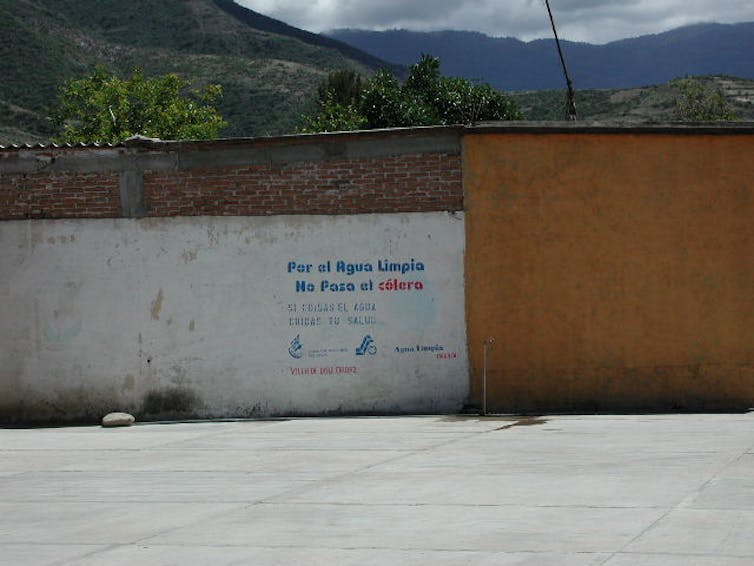
Jeffrey H. Cohen
The lack of potable water additionally increases the risk that intestinal problems like cholera, among other health conditions common in rural Indigenous populations, will exacerbate the effects of COVID-19.
The Mexican government has committed to build more rural hospitals, including in Oaxaca. But the virus moves faster than construction crews. The Zapotec’s best bet, they know, is still themselves.
Editor’s note: This story has been updated to accurately characterize the Indigenous inhabitants of the village Santos Reyes Yucuná.
Jeffrey H. Cohen, Professor of Anthropology, The Ohio State University
This article is republished from The Conversation under a Creative Commons license. Read the original article.

